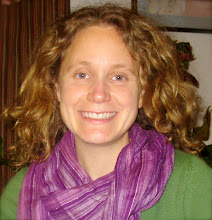I discovered Dr. Bryan Baisinger, owner of Clearwater Clinic in downtown Portland, when I was training for the Portland Marathon in 2005. He's the medical director for the PortlandFit Marathon Training Program and the doctor who helped me run 26 miles.
After training for several months, my left hip suddenly locked up as I was driving to work. I could barely lift my leg to clutch and walking up stairs was difficult. Even though I was a new patient, he saw me during his lunch break, cracked my back (ahhhhh) and externally massaged my hip loose. I left his office walking normally and ready to run again. But the same thing kept happening over and over and Dr. Baisinger recommended trigger point and myofascial release work.
Since my muscles refused to permanently release using external pressure, Dr. Baisinger suggested using fingertip pressure from inside the vagina to release the myofascial trigger points that were causing me problems. All I wanted to do was run the marathon, so I was up for anything. Within 4 treatments, I ran my first marathon with no pain at all. I had zero recovery and was out walking the very next day (while my husband was puking from drinking too much at my celebration party).
I know I never would have been able to run half that distance if it wasn't for Dr. Baisinger's amazing knowledge of trigger point and myofascial release techniques. Using this healing, Dr. Baisinger is able to release internal and external pelvic tissues that are hypersensitive to light pressure and traction. He uses hands-on manual methods like active muscle release, skin rolling and ultrasound with muscle stimulation to treat trigger points and myofascial restrictions.
During a recent interview, Dr. Baisinger gave me more insight into the procedure.
(CKJ): How does this work help pregnant and postpartum women specifically?
(Dr.B): With pregnancy related physical changes mild pelvic pain issues may become more pronounced and women with significant pain may experience an increase as well. Normalizing the tone of the pelvic floor muscles and tissue allows for needed expansion during pregnancy and vaginal birth. Postpartum, muscle imbalances can be addressed as the pelvic region re-calibrates the resting tone settings. Once any torn tissue has healed, ultrasound is excellent to restore plasticity to excessively hardened scar tissue. Stress incontinence is common and often resolved by normalizing the myofascial tissue neighboring the urethra and pubic symphysis area."
(CKJ): What are some symptoms that may tip off a woman to explore this type of healing?
(Dr. B): If you have difficulty or pain sitting, clitoral/vaginal/genital pain, stress incontinence, post operative pain, urinary urgency, incomplete voiding, pain with sexual relations, pain in legs and feet, irritable bowel symptoms, PMS lasting more than 24-48 hours, these are good indicators that you should see what relief myofascial release techniques can help with.
Your pelvic floor controls all sorts of postures and movements, not to mention bladder and bowel functions and genital tissues. The volume of neurologic information transferring in and out of the region is not always coordinated. It sounds odd but sometimes muscles are capable of working but cannot due to the pain they would cause by contracting forcefully. Trigger point and myofascial release can help.
I feel very strongly that it is important for people with non-resolving acute or chronic pelvic pain make sure to keep pursuing help until the condition is resolved completely or the limiting factors are understood. Doctors and healthcare providers who take their patient outcome results personally act their best professionally.
Dr. Baisinger is offering a 1 day workshop at Birthingway College of Midwifery called Trigger Point and Myofascial Release Techniques for the Female Pelvic Floor. This workshop is open to practicing Midwives and Midwifery students. In this hands on workshop, Dr. Baisinger will teach women how to administer remedial trigger point and myofascial release treatments for both prenatal and postpartum times. These release skills help women achieve a non-medicated vaginal birth and can be taught to women so they can treat themselves.
If you're interested in finding out more about this work, Dr. Baisinger recommends starting with the International Pelvic Pain Society and searching the web with terms like "manual therapy" and "non-surgical". Of course, people are always welcome to call Clearwater Clinic to find out more information.

No comments:
Post a Comment